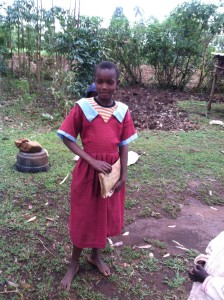
Education holds a great promise for the lives of young people, the growth of nation,s and the strengthening of communities in general. Nowhere will you find more people say that “Knowledge is power” or the promise of a future, than here in East Africa.
Education prepares our youth to be responsible young adults as they look forward to taking on greater responsibilities in the world. Learning how to solve problems, and building desire and capacity to learn, represent the fundamentals of real education. The prevailing view in our area is that education is the means of creating a better nation–free from poverty, diseases and ignorance.
The nation of Kenya has came a very long way in establishing and re-establishing its public education system over the years. The first missionaries who came to the land, Johann Ludwig Krapf and Johannes Rebmann (in the year of 1728) worked with a Swahili manuscript Utendi Wa Tambuka (Book of Heraclius) and established the first mission schools in the country at Rabai, in the coast of Mombasa in 1846. The zeal and thirst for education was stirred and aroused among the people of Kenya. Both government and non-governmental organizations have given education higher advantage, and invested heavily in its provision.
After the end of colonial administration, Kenya government began a campaign to give free public primary education in 1963. Since then, the system and structure of education has undergone transformation and reformation three times. First the system of public education was established in the format of 7-4-2-3: 7 years of primary education, 4 years of secondary education, 2 years of high school and 3-5 years of university education. This system resembles the British public education,wherein children begin their elementary ( primary) education at the age of 7 and complete at age of 13 after sitting for final examination.
In the year of 1985, a new system was introduced, 8-4-4: 8 years of primary education, 4 years of secondary, and 4 years of university education. Two weeks ago, the ministry of education introduced a new system of 2-7-3-3: 2 years in kindergarten, 7 years in primary school, 3 years in secondary school and 3 years in university.
Public Primary Education
Since 2003, education in public schools became free and compulsory. This resulted in high pupil enrollment, overwhelming the number of teachers. In some parts of the country it was reported that one classroom contained 100 pupils with only one teacher. Primary education is free by law. Parents are, however, required to provide essential supplements that are needed in the learning environment which Kenya government cannot provide: school uniforms (at a cost of 8000-10000 KSH, or $8-$10), fees for desks (500-1000 KSH), lunch fees (1000 KSH) and extra-curricular activities fees (500 KSH).

Primary education begins at the age of 6-7 after completion of 2 years in kindergarten. The first class or year of primary school is known as standard one, and the final is standard seven. Primary children are called pupils. School semesters at both primary and secondary begin in January and ends in November. Students get three school vacations in April, August and December. The school day starts at 8 a.m and finishes at 4 a.m, from Monday to Friday. Depending on where a child goes to school in relation to home, he may get up while it is still dark to begin the long walk school.
Public Secondary Education
Public secondary schools are divided into three levels: national, provincial and district.. Pupils with the highest scores from primary schools gain admission into national schools, which are more prestigious and offer quality education compared to provincial and district schools. National schools charge higher fees than provincial and districts schools, at least 70,000-80,000 KSH every year. That’s $700-$800; if the average daily wage is 500 KSH, or about $1750 per year, that’s almost half of a family’s annual income! However, if one is accepted into a national school, few parents would refuse to struggle and make payment.
Pupils with average grades will find admission in provincial and district schools, which are still difficult for families to afford. An average provincial school charges 40,000-50,000 KSH ($400-$500) every year, while the district schools might charge only 10,000-20,000 KSH ($100-200) per year. School fees are paid in three terms. In 2008, the government introduced plans to offer free secondary education to all Kenyans, but this has not been successful implemented.
Principal subjects offered in public secondary schools are: English, Swahili, Mathematics, History and Government, Geography, Physics, Chemistry, Biology, Religious Education, Business and Agricultural Studies.
Even free primary school has fees that add up and challenge the average family; once one or more children are enrolled in secondary school, paying school fees is a constant challenge and a burden. However, even those we would consider the most poverty-stricken willingly sacrifice to give their children as much education as possible, as an investment in their future. Currently, Kingdom Driven Ministries does not assist with paying school fees for children, except in very special cases, simply because the need is just too great. However, we ask you to pray for all of the parents in our towns and villages who want to give their children the very best hope for the future, and struggle so much to provide it through education.
